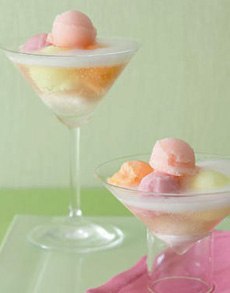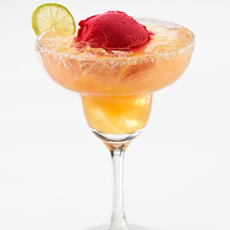TIP OF THE DAY: Sorbet Cocktail For Dessert
|
How can you make a sophisticated dessert in less than five minutes? Cleanse the palate after a rich dinner? Serve something cool and refreshing? Combine dessert with an “after dinner drink?”
Serve a sorbet “cocktail” or mocktail, which in its simplest version combines a scoop of sorbet with sparkling wine or ginger ale. A sorbet cocktail is an ideal use for “sherbet Champagne” glasses. Purportedly designed by Marie Antoinette, who had them molded after her breasts, the wide mouth glass is not appropriate for sparkling wine—it lets the bubbles escape that much more quickly. But they’re just fine for serving sorbet, fruit cocktail and other foods, or this cocktail. |
|
|
|
Optionally, use a Martini glass, a Margarita glass or a wide bowl wine glass. If you have room in the freezer, chill the glasses before assembling the drink. TIP: Instead of using one flavor of sorbet, you can use mini scoops of two or three different flavors. Add the alcohol first, then the sorbet, because pouring liquid over the sorbet balls will make them melt faster and diminish the initial appearance of the drink. Ingredients Per Cocktail 1. SCOOP balls of sorbet and reserve in freezer until ready to use. 2. POUR sparkling wine into glass. Gently add sorbet ball. Garnish as desired and serve immediately with a dessert spoon. |
||
 You can use smaller scoops of sorbet in different flavors. Photo courtesy EverydayCelebrating.com. |
RECIPE #2: SORBET COCKTAIL WITH VODKA OR OTHER SPIRIT
This recipe uses higher proof spirits (40% A.B.V.) instead of the much lower in alcohol sparkling wine (5% to 7% A.B.V.). So unless you’re a liquor-loving crowd, dilute the spirit with juice instead of using it straight. Scroll down for an explanation of A.B.V. versus proof. 1. SCOOP balls of sorbet and reserve in freezer until ready to use. Prepare citrus curls and zest. |
|
|
2. COMBINE spirit and juice and chill until ready to serve. Assemble (liquid first, then sorbet and garnish) and serve immediately with a dessert spoon. Be prepared: Guests may want “seconds.” A.B.V., alcohol by volume, is the percentage of alcohol in any product. Wines typically vary from 10% to 14% A.B.V.; fortified wines like port can have 18% A.B.V. Beer can range from 3.5% to 9% or higher, depending on the style and the brewing process. “Proof” is double the A.B.V. Most spirits are distilled to 40% A.B.V., 80 proof (some are higher, some are lower). Why is it called “proof?” Beginning in the 1700s until January 1, 1980, the U.K. measured alcohol content in terms of “proof spirit,” defined as a “spirit with a gravity of 12/13 that of water, or 923 kg/m3, and equivalent to 57.15% A.B.V.” The term originated when payments to British sailors included rations of rum. To ensure that the rum had not been watered down, it was “proved” by dousing gunpowder with it and then testing to see if the gunpowder would ignite. If it did not, then the rum contained too much water and was considered to be “under proof.” Gunpowder would not burn in rum that contained less than approximately 57.15% ABV. Therefore, rum that contained this percentage of alcohol was defined to have “100° [one hundred degrees] proof.” (Source: Wikipedia.)
|
||



